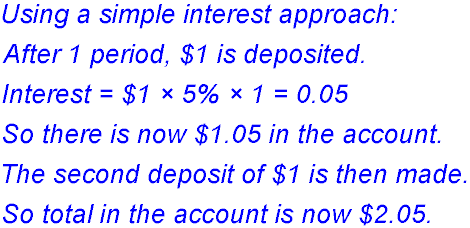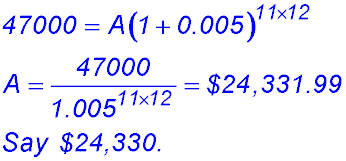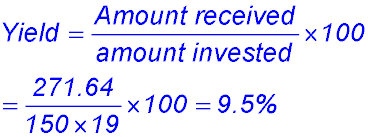Where the techniques of Maths
are explained in simple terms.
Financial Maths - Annuities and Future value tables.
Test Yourself 1.
- Algebra & Number
- Calculus
- Financial Maths
- Functions & Quadratics
- Geometry
- Measurement
- Networks & Graphs
- Probability & Statistics
- Trigonometry
- Maths & beyond
- Index
Answer the following questions using the table included elsewhere when required:
| Interest factors. | 1. (i) 
|
| 2. The interest factor for 13 periods at an interest rate of 12% per period
is 28.0291. If $1 was invested @ 12% per year, then after 13 years the amount invested would have grown to $28.03. |
|
| Find the future value of an annuity. | 3. Investment = $3,000 Interest factor = 26.8704. Future value = 26.8704 × 3000 = $80,611.20. |
4. Investment = $5,500 Interest factor = 21.5786. Future value = 21.5786 × 5500 = $118,682.80. |
|
5. Investment = $10,000 Interest factor = 39.0826. Future value = 39.0826 × 10000 = $390,826. |
|
6. Investment = $450 Interest factor = 36.7856. Future value = 36.7856 × 450 = $16,553.52. |
|
7. Investment = $1,000 Interest factor = 27.2990. Future value = 27.2990 × 1000 = $27,299. |
|
8. Investment = $300 Interest factor = 26.9735. Future value = 26.9735 × 300 = $8,092.05. |
|
| Find the contribution required. | 9. Interest = 6% - half-yearly = 3% N = 6 × 2 = 12 Interest factor = 14.1920 Investment amount × 14.1920 = $10,664 Investment amount = $750.00. |
| 10. Interest = 5% yearly N = 7 Interest factor = 8.1420 Investment amount × 8.1420 = $22,500 Investment amount = $2,763.45 - so (say) $2,770. |
|
| Equivalent single sum investments. | 11. Investment = $250 Interest factor = 51.9944. Future value = 51.9944 × 250 = $12,998.60. Using the usual compound interest formula:
|
12. Future value = $47,000. Using the usual compound interest formula for monthly interest:
|
|
| Calculating interest. | 13. (i) Investment = $500 Interest = 10% - half yearly = 5% N = 10 × 2 = 20. Interest factor = 33.0660. Future value = 33.0660 × 500 = $16,533 Alyssa had $16,533 invested after 10 years. (ii) Alyssa has deposited $500 into her superannuation account on 20 occasions - so a total of $10,000. Hence she has earned $6,533 interest. |
| 14. (i) First deposit of $150 earned compound interest for 19 months at the rate of 1% p.m.
∴ Total value = $150 × 1.0119 = $181.22. (ii) Investment = $150 Interest factor = 20.8109. Future value = 20.8109 × 150 = $3,121.64 Jess had $3,121.64 invested after 19 months. (iii) Jess has deposited $150 into her superannuation account on 19 occasions - so a total of $2,850. Hence she has earned $271.64 interest. (iv) |
|
| Comparing investments | 15. Investment 1 = $8,000 Interest factor = 9.5491. Future value = 9.5491 × 8000 = $76,392.80. Investment 2 = $10,000 Interest factor = 9.38. Future value = 9.38 × 10,000 = $93,800. The difference is that an extra $2,000 p.a. was contributed to the Investment 2 over the 8 years - giving an extra $16,000. The remaining difference between the two investments is the extra interest amounts accruing for Investment 2 throughout the period from the additional investment contributions. |
16. Investment 1 = $5,000 Interest factor = 9.2142. Future value = 9.2142 × 5000 = $46,071. Investment 2 = $3,500 Interest factor = 13.4121. Future value = 13.4121 × 3,500 = $46,942.35. The difference between the two strategies is small - only about $900. Investment 1 requires the deposit of $40,000 over 4 years while Investment 2 requires the deposit of $42,000 over 3 years. Investment 2 finishes one year ahead of Investment 1 and, as money means more the sooner it is received, Investment 2 is the better option. |


